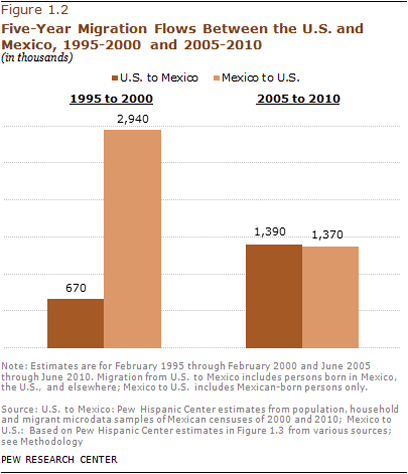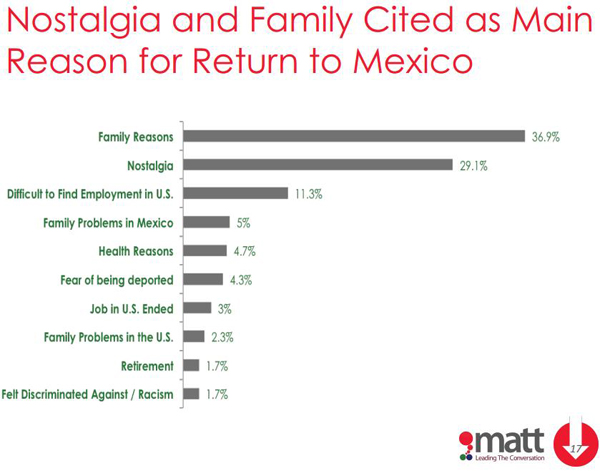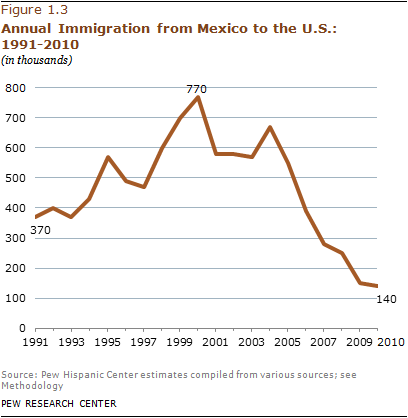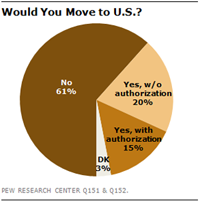Zero Net Migration Between Mexico and United States | Cero migración
By Enrique Berruga Filloy
El Universal (Spanish) | Watching America (English) | Princeton Univ | Pew Research Center
English | Spanish
Translated from the Spanish by Brandee Bilotta, edited by Andrew Schmidt
“For the first time in 60 years, the net traffic of Mexicans to the United States has been reduced to zero and perhaps even shows a negative balance.”
Princeton University established this in its most recent study of immigration.
This news has profound structural implications for bilateral relations. The study’s repercussions with regard to the presidential campaign in the neighboring country should be lethal for those who try to use immigration as an instrument to obtain votes from the more radical sectors of the United States.
 How was this discovery validated?
How was this discovery validated?
Since 2009, Princeton’s Mexican Migration Program has undertaken thousands of studies among Mexicans in the United States. In these three years, none of the civilians interviewed indicated that they would be crossing the border for the first time. That is to say, migrants had already been in the neighboring country. The net result is precisely that immigration has not increased: As the study shows, there has been no growth or even a decrease, if one considers that many civilians have returned to Mexico without intentions to cross the border again.
The reasons that explain this phenomenon are on both sides of the border.
From the American side, the decrease in migratory tides is associated with the economic recession that gestated in 2008 and for now has reduced the demand of Mexican labor, especially in the field of construction. While the voice keeps spreading that there are no job offers, civilians simply don’t risk life and patrimony to cross to the other side.
The second explanation this study reports is the extreme anti-immigration measures that have been applied in states like Alabama and Arizona. The action of the police, under whatever circumstance and above all basing it on people’s racial profile, which can require the presentation of immigration documents, has not only provoked civilians to leave these two states for others in the U.S., but simply prevented them from crossing into the north.
The reasons found in the study on the Mexican side are perhaps more interesting. Fewer Mexicans look to go to the United States because levels of well being have increased. In the last ten years, Mexico has recorded higher access to education and health services. Only 3 percent of the population lives in homes with dirt floors. And lastly, the salary differential between the U.S. and Mexico has gone from being an average ten times higher to only four times higher.
 The concrete fact is that in the last two years, detentions of undocumented persons on the border have fallen by 70 percent. Because of this, while the rhetoric of some politicians and North American extremist groups keeps calling for reinforcement of the border patrol, the use of unmanned planes and the erection of walls, reality has already surpassed them.
The concrete fact is that in the last two years, detentions of undocumented persons on the border have fallen by 70 percent. Because of this, while the rhetoric of some politicians and North American extremist groups keeps calling for reinforcement of the border patrol, the use of unmanned planes and the erection of walls, reality has already surpassed them.
Understand that neither of the two governments is taking advantage of the revelations of this study.
From the U.S. side, the government could launch a totally new initiative of immigration reform, for now they could regularize those foundations that have already been found residing there. They can’t utilize the argument that giving amnesty to actual immigrants will bring a wave a new illegal crosses. They already aren’t crossing. A measure of this type could stabilize immigration now and forever, regulating future waves with work visas.
 The second point is that, after a 60-year discussion, it has been revealed empirically that economic and social development from the Mexican side is the best way of dealing with the immigration phenomenon. The support and investment that the U.S. does in Mexico should form part of its public politics. Furthermore it could be great business for Washington, given that Mexico imports more goods and services from the United States than the four most powerful European economies combined.
The second point is that, after a 60-year discussion, it has been revealed empirically that economic and social development from the Mexican side is the best way of dealing with the immigration phenomenon. The support and investment that the U.S. does in Mexico should form part of its public politics. Furthermore it could be great business for Washington, given that Mexico imports more goods and services from the United States than the four most powerful European economies combined.
For Mexicans it could be the propitious moment to reposition the immigration agenda, actively stimulate a regularization mechanism for civilians, and insist that the prosperity of Mexico is in the best interest of the United States. It could liberate the 52 consulates that Mexico has in the U.S. in charge of protection affairs, to put forward fully the promotion of our economy and our culture. It would have to insist on the growth of Mexico not only to help with the U.S.’ social and security worries, but also to directly contribute to their own economic expansion.
It is the moment to design new architecture for bilateral relations. The initiative, inevitably, should proceed from the Mexican side. For a project of this importance, it’s never too late in a six-year term.
Sources: El Universal (Spanish) | Watching America (English) | Princeton University | Pew Research CenterPor Enrique Berruga Filloy
El Universal
inglés | español
“Por primera vez en 60 años, el tráfico neto de mexicanos a Estados Unidos se ha reducido a cero y quizá arroje incluso un saldo negativo”.
Así lo establece el más reciente estudio de la Universidad de Princeton sobre migración.
Ésta sí que es una noticia con profundas implicaciones estructurales para las relaciones bilaterales. Las repercusiones del estudio sobre las campañas presidenciales en el vecino país deben ser letales para quienes pretenden utilizar la migración como instrumento para la obtención de votos de los sectores más radicales de Estados Unidos.
¿Cómo se llegó a validar este hallazgo?
Desde 2009, el Proyecto de Migración Mexicana de la Universidad de Princeton ha realizado miles de encuestas entre mexicanos que se encuentran en Estados Unidos. En estos casi tres años ninguno de los paisanos entrevistados indicó que estuviera cruzando a territorio estadounidense por primera vez. Es decir, estos migrantes ya habían estado previamente en el vecino país. El resultado neto es precisamente que la migración no se ha incrementado: equivale, como lo señala el estudio, a un crecimiento cero o incluso negativo, si se considera que muchos paisanos han vuelto a México sin intenciones de volver a cruzar la frontera.
Las razones que explican este fenómeno están a ambos lados de la línea divisoria.
Del lado estadounidense la disminución de corrientes migratorias se asocia con la recesión económica que se gestó en 2008 y que por ende ha reducido la demanda de mano de obra mexicana, especialmente en el ramo de la construcción. Al correrse la voz de que no hay oferta de empleos, los paisanos simplemente no arriesgan la vida y su patrimonio para cruzar al otro lado.
La segunda explicación que reporta este estudio son las medidas antimigratorias extremas que se han aplicado en estados como Alabama y Arizona. El hecho de que la policía, bajo cualquier circunstancia y sobre todo basándose en el perfil racial de las personas, pueda exigir la presentación de documentos migratorios, no sólo ha provocado que los paisanos se vayan de esos dos estados hacia otros dentro de Estados Unidos, sino que se abstengan simplemente de cruzar al norte.
Las razones que encuentra el estudio del lado mexicano son quizá más interesantes. Menos mexicanos buscan ir a Estados Unidos porque los niveles de bienestar en nuestro país han aumentado. En los últimos 10 años, México ha registrado mayor acceso a la educación y los servicios de salud. Sólo 3% de la población habita en sitios con piso de tierra. Y por último, el diferencial de salarios entre Estados Unidos y México ha pasado de ser 10 veces más alto al promedio del nuestro, a solamente cuatro veces mayor.
El hecho concreto es que en los últimos dos años, las detenciones de indocumentados en la frontera han caído en 70%. Así, mientras la retórica de algunos políticos y grupos extremistas norteamericanos sigue llamando por un reforzamiento de la Patrulla Fronteriza, el desplazamiento de aviones no tripulados y la erección de muros, la realidad ya los tiene rebasados.
Llama poderosamente la atención que ninguno de los dos gobiernos esté aprovechando las revelaciones de este estudio.
Del lado estadounidense, el gobierno podría lanzar una iniciativa totalmente inédita de reforma migratoria, pues ahora sí tendría bases para regularizar a los que ya se encuentran residiendo allá. Ya no puede utilizarse el argumento de que dar amnistía a los migrantes actuales va a traer una oleada de nuevos cruces ilegales. Ya no están cruzando. Una medida de este tipo podría estabilizar de una vez y para siempre los flujos migratorios, regulando oleadas futuras mediante visas de trabajo.
El segundo punto es que, después de una discusión de 60 años, se revela empíricamente que el desarrollo económico y social del lado mexicano es la mejor fórmula para atender el fenómeno migratorio. El apoyo y las inversiones que haga Estados Unidos en México deben formar parte de sus políticas públicas. Y además sería un gran negocio para Washington, dado que México importa más bienes y servicios de Estados Unidos que las cuatro economías europeas más poderosas, combinadas.
De la parte mexicana sería el momento propicio para reposicionar la agenda migratoria, impulsar activamente un mecanismo de regularización para paisanos e insistir en que la prosperidad de México está en el mejor interés de Estados Unidos. Se podría liberar a los 52 consulados que tiene México en Estados Unidos de la carga casi única de dedicarse a temas de protección, para meterse de lleno a la promoción de nuestra economía y nuestra cultura. Habría que insistir en que el crecimiento de México no sólo les ahorra preocupaciones sociales y de seguridad a los estadounidenses, sino que abona directamente en su propia expansión económica.
Es el momento de diseñar una nueva arquitectura para las relaciones bilaterales. La iniciativa, inevitablemente, debe provenir de la parte mexicana. Y debe ser vigorosa. Para un proyecto de esta importancia, nunca es muy tarde en un sexenio.
Fuente: El Universal








Comments
Zero Net Migration Between Mexico and United States | Cero migración — No Comments